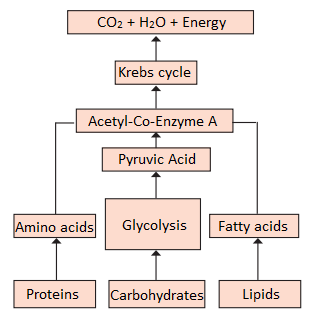Class 10 MAHARASHTRA STATE TEXTBOOK BUREAU Solutions Science Chapter 2 - Life Processes in Living Organisms Part -1
Life Processes in Living Organisms Part -1 Exercise Exercise
Solution 1
- After complete oxidation of a glucose molecule, 38 number of ATP molecules are formed.
- At the end of glycolysis, pyruvate molecules are obtained.
- Genetic recombination occurs in pachytene phase of prophase of meiosis-I.
- All chromosomes are arranged parallel to equatorial plane of cell in metaphase phase of mitosis.
- For formation of plasma membrane, phospholipid molecules are necessary.
- Our muscle cells perform anaerobic type of respiration during exercise.
Solution 2
- Nutrition: The process of intake of nutrients in the body and their utilisation by an organism is known as nutrition.
- Nutrients: Substances like carbohydrates, proteins, lipids, vitamins and minerals which are components of food are called nutrients.
- Proteins: Protein is a macromolecule formed by many amino acids which are joined together by peptide bonds.
- Cellular respiration: Oxidation of glucose and other food components which takes place inside the cell in the presence or absence of oxygen, is known as cellular respiration.
- Aerobic respiration: Cellular respiration which takes place in the presence of oxygen is known as aerobic respiration.
- Glycolysis: The process occurring in the cell where a molecule of glucose is oxidised in a step by step process forming two molecules each of pyruvic acid, ATP, NADH2 and water, is called glycolysis.
Solution 3.a
Differences between glycolysis and TCA cycle:
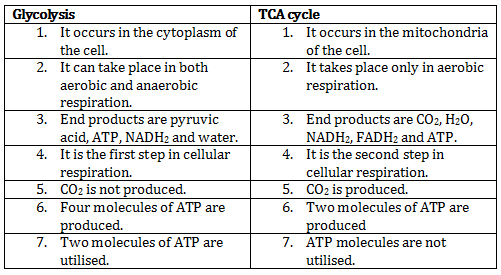
Solution 3.b
Differences between mitosis and meiosis:
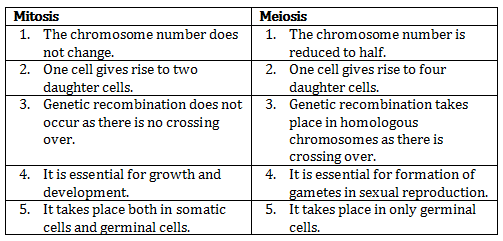
Solution 3.c
Differences between aerobic respiration and anaerobic respiration:
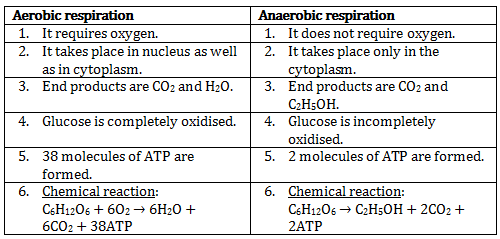
Solution 4.a
- When glucose is completely oxidised in the presence of oxygen during aerobic cellular respiration, it produces 38 molecules of ATP.
- In cellular respiration, three processes take place one after the other - glycolysis, Krebs cycle and electron transport chain reactions.
- Of these processes, only glycolysis takes place when glucose is oxidised in the absence of oxygen. This reaction produces alcohol.
- Only two molecules of ATP are produced during glycolysis. This results in less energy supply to the body.
- Therefore, oxygen is necessary for complete oxidation of glucose to obtain maximum energy.
Solution 4.b
- Fibres are indigestible substances. They are eliminated out of the body along with other undigested matter. This aids in egestion.
- Some fibres also help in digestion of other substances.
- Green leafy vegetables, fruits and, cereals are considered as an important part of the diet because they supply nutritious fibres.
- Thus, fibres are considered as one of the important nutrients.
Solution 4.c
- Cell division is very essential for all the living organisms. Growth and body development is possible only due to cell division.
- The emaciated body can be restored only through cell division which adds new cells to the body.
- Cell division in the parental cell produces an offspring.
- In asexual reproduction, mitotic cell division helps to produce daughter cells and give rise to a new generation.
- In sexual reproduction, meiotic cell division helps to form haploid gametes.
- Thus, cell division is one of the important properties of cells and organisms.
Solution 4.d
- Aerobic respiration is not possible when there is a deficiency of oxygen in the surrounding.
- In order to survive in such cases, higher plants switch to anaerobic respiration.
- In some animal tissues, cells respire anaerobically in the absence of oxygen to provide the required energy for the body.
- Thus, higher plants and animals too perform anaerobic respiration under certain situations.
Solution 4.e
- Krebs cycle involves a series of cyclic chain reactions which begins with acetyl-coenzyme-A molecules.
- Acetyl-CoA, a 2-carbon compound enters the mitochondria to combine with oxaloacetic acid, a 4-carbon compound to form a 6-carbon compound called citric acid.
- Since, the first stable product formed in this cycle is citric acid, Krebs cycle is also called citric acid cycle.
Solution 5.a
Glycolysis
- Glycolysis is the first step of cellular respiration. It takes place in the cytoplasm of the cell. It is common for both aerobic and anaerobic respiration.
- In aerobic respiration, there is step-wise oxidation of glucose molecule forming two molecules each of pyruvic acid, ATP, NADH2 and water.
- Later, pyruvic acid formed in this process is converted into acetyl-CoA along with two molecules of NADH2 and two molecules of CO2.
- During anaerobic respiration, fermentation also occurs along with glycolysis. This results in incomplete oxidation of glucose and thus formation of lesser energy.
- The process of glycolysis was discovered by Gustav Embden, Otto Meyerhof, and Jacob Parnas. Therefore, in their honour, glycolysis is also called the EMP pathway.
Solution 5.b
Mitosis
Mitosis is divided into two stages:
- Karyokinesis or nuclear division and
- Cytokinesis or cytoplasmic division
a. Karyokinesis: It takes place in four phases - prophase, metaphase, anaphase and telophase.
i. Prophase: During prophase, condensation of chromosomes begins. Thin, thread-like chromosomes start thickening and appear as pair of sister chromatids. In animal cells, the centrioles duplicate and move towards the opposite poles of the cell. Nuclear membrane and nucleolus disappear.
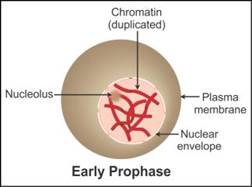
ii. Metaphase: Chromosomes complete their condensation and get arranged along the equatorial plane of the cell. The spindle fibres are formed from polar region, where centrioles are present, and they attach themselves to the centromere of each chromosome. Nuclear membrane disappears completely.
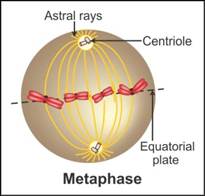
iii. Anaphase: The centromeres of the chromosomes now divide forming two daughter chromosomes. The spindle fibres pull apart the chromosomes from equatorial region to the opposite poles. Chromosomes moving to the poles appear like bunch of bananas. One set of chromosomes reaches each pole by the end of anaphase.
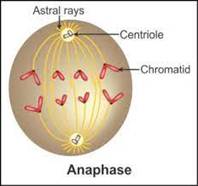
iv. Telophase: The thickened chromosomes decondense. They resume their thin and thread-like appearance. Nuclear membrane and nucleolus reappear. The spindle fibres are completely lost. The cell appears as if it has two nuclei in one cytoplasm.
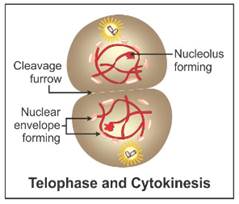
b. Cytokinesis: In animal cells, a notch develops in the middle of the cell. This notch goes on deepening down and followed by the division of the cytoplasm. In plant cells, cell plate formation takes place and then cytokinesis takes place.
Solution 5.c
Prophase-I is the longest phase of meiosis. It is divided into five sub-stages, namely leptotene, zygotene, pachytene, diplotene, and diakinesis.
1. Leptotene: The chromosomes begin to condense and become compact.

2. Zygotene: The homologous chromosomes start pairing by a process called synapsis. The structure called synaptonemal complex develops to hold chromosomes in place during this pairing. The chromatid arm of each chromosome divides and forms a structure called bivalent or tetrad.
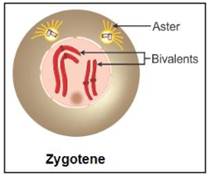
3. Pachytene: Crossing over of non-sister chromatids of homologous chromosomes takes place. Genetic recombination occurs due to such exchange. The homologous chromosomes still remain paired together at the site of crossing over.
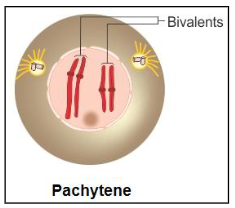
4. Diplotene: Synaptonemal complex dissolves and the homologous chromosomes of the bivalents separate except at the point of crossing over. Thus, it resembles X-shaped structures called the chiasmata.
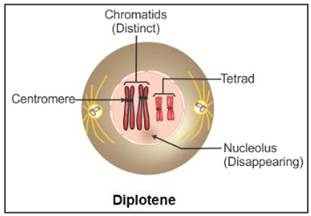
5. Diakinesis: The last phase of prophase is for termination of chiasmata. The spindle fibres originate, and the cross-over homologous chromosomes are now separated. The nucleolus disappears, and the nuclear envelope breaks down.

Solution 5.d
- Different body systems work in coordination with each other in the body of living organisms. Homoeostasis is very advanced in the human body.
- Digestive system, respiratory system, circulatory system, excretory system, nervous system and all the external and internal organs in the body work independently but in coordination with each other.
- The digested and absorbed nutrients of the food are transported to various cells with the help of circulatory system. Simultaneously, the oxygen absorbed in the blood by the lungs is also transported to each body cell by the RBCs.
- Mitochondria in every cell bring about oxidation of nutrients and produce energy required for all various life activities.
- Control over the bodily functions is exercised by the nervous system. This keeps the organism alive and helps in overall growth and development.
Solution 5.e
- Krebs cycle was proposed by Sir Hans Krebs. It is also called tricarboxylic acid cycle or citric acid cycle.
- Krebs cycle is a cyclic process that occurs in the mitochondrial matrix, in the presence of oxygen.

- The cycle starts with the condensation of an acetyl group with oxaloacetic acid and water to form citric acid, along with the release of CoA molecule. The enzyme involved in this conversion is citrate synthase.
- Citrate then isomerises to form isocitrate.
- The synthesis of citrate is followed by two successive steps of decarboxylation - first, the formation of a-ketoglutaric acid, and then, the formation of succinyl-CoA.
- The succinyl-CoA gets oxidised to form malic acid, which in turn gets converted into oxaloacetic acid, thereby allowing the cycle to continue.
- Krebs cycle yields molecules of CO2, H2O, NADH2, FADH2 and ATP upon complete oxidation.
Solution 6
Energy formation from the oxidation of carbohydrates, fats and proteins:
- All the dietary carbohydrates are digested in the digestive system with the help of various enzymes and converted into glucose. Similarly, proteins are converted into amino acids and fats are broken down into fatty acids and glycerol.
- Oxidation of carbohydrates takes place during cellular respiration. Glucose is oxidised by three steps during aerobic respiration, viz. glycolysis, tricarboxylic acid cycle or Krebs cycle and electron transport chain.
- From one molecule of glucose, two molecules each of pyruvic acid, ATP, NADH2 and water are formed during glycolysis. Pyruvic acid is converted into acetyl-Co-A.
- In the next step, i.e. in TCA cycle, molecules of acetyl-Co-A enter the mitochondria and a cyclic chain of reactions take place. Acetyl part of acetyl-Co-A is completely oxidized in this process. CO2, H2O, NADH2 and FADH2 are released in this process.
- In the third step, i.e. in electron transport chain reaction, NADH2 and FADH2 formed during the first two steps are used for obtaining ATP molecules. 3 molecules of ATP are obtained from 1 molecule of NADH2 while 2 molecules of ATP are obtained from 1 molecule of FADH2.
- Thus, one molecule of glucose upon complete oxidation in the presence of oxygen yields 38 molecules of ATP. This is energy is obtained from the oxidation of carbohydrates.
- If carbohydrates are insufficient in the diet, then proteins or lipids are used for energy production. Fatty acids derived from fats and amino acids derived from proteins are converted into Acetyl-Co-A. Acetyl-Co-A once again can yield energy through the above steps of the Krebs cycle.
Corrected diagram
